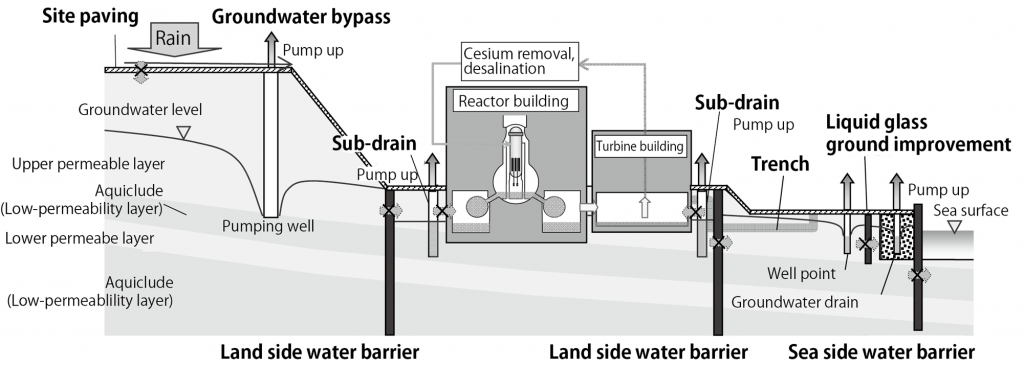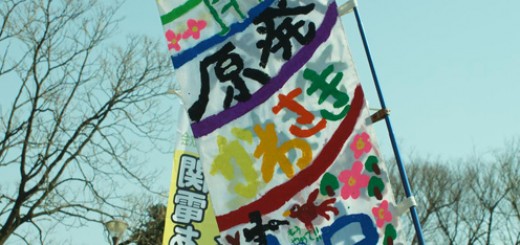What’s happening with the contaminated water at the crippled Fukushima nuclear plant? -Nuke Info Tokyo No.166
It was disclosed on February 24 that highly radioactive water was leaking from the “K” drainage channel of the Fukushima Daiichi Nuclear Power Station (FDNPS) and was flowing directly into the ocean outside the plant’s harbor.
Earlier, Tokyo Electric Power Co. had reported to the Nuclear Regulation Authority (NRA) in January 2014 that the radiation level of the water in the drainage channel was high. However, NRA did nothing, saying the rain water was not subject to official restriction. The nuclear watchdog then instructed the utility to devise measures to reduce the water’s contamination level and to formulate rainwater control plans within one year. This means that NRA left this matter solely in the hands of the plant.
Local residents and the fisheries cooperative were astonished by the revelation of the leakage of the highly radioactive water into the ocean, and made an enraged public outcry against NRA and TEPCO.
In response, NRA Chairman Shunichi Tanaka declared that his commission was not in a position to provide instructions on everything, including ‘how to use chopsticks.’ Naohiro Masuda, president of TEPCO’s Fukushima Daiichi Decommissioning Co., maintained that he had never thought of the need to disclose the water leakage to the public. Indications are that neither the plant operator nor the nuclear watchdog had any intention of taking responsibility for the contaminated water leakage. This is an incident that symbolizes the chaotic situation caused by the growing amount of highly radioactive water accumulating at the nuclear plant.
“Specific Nuclear Power Facility”
The Fukushima plant was designated a “specific nuclear power facility” on November 7, 2012. This new classification category was created because the current situation at the plant is beyond the scope of the assumptions of the Nuclear Reactor Regulation Law. The unprecedented situation includes the problem that the whereabouts of the melted nuclear fuel are still unknown, that the premises, facilities and equipment are contaminated with highly radioactive substances, and that measures against the severe nuclear accident are being taken.
The specific nuclear power facility is required to take steps to, for example, protect the premises and its surrounding areas from contamination by radioactive substances by cutting the amount of radioactive substances released from the plant. The target of this requirement is to lower the effective annual air dose level in the border areas of the plant’s premises to less than 1 millisievert per year by the end of March 2013. The effective radiation dose is affected by the debris and contaminated water stored on the premises since the outbreak of the nuclear accident. However, this requirement has not been met because contaminated water continues to flow into the ocean, and TEPCO is unable to stop the release of radioactive substances. As a result, FDNPS is still unable to achieve this target .
Building basements becoming storage pools of highly radioactive water
TEPCO has been injecting 400 tons (currently 320 t.) of water into the reactors daily for the past four years to cool the molten nuclear fuel there. This water, containing high-level radioactive substances, is flowing into the basements of buildings, where it mixes with a massive amount of sea-water remaining from the tsunami as well as groundwater leaking from cracks and other damaged parts of the buildings, which also totals around 400 t. (currently 320 t.) per day. This indicates that the basements of the Unit 1-4 buildings have already become storage pools of highly contaminated water.
The utility is removing cesium and salt from the radioactive water, returning about 400 t. of processed water into the reactors to cool the melted nuclear fuel, and diverting the remaining 400 t. into storage tanks built on the premises.
The total amount of toxic water generated at the plant has already reached roughly 600,000 t. Under these circumstances, it is highly likely that the growing amount of contaminated water, and piles of solid waste from the removal of debris may further push up the plant’s effective air dose level.
Advanced Liquid Processing System (ALPS)
In 2013, TEPCO introduced the Advanced Liquid Processing System (ALPS) to deal with the ever-increasing volumes of highly contaminated water at the Fukushima plant. Since then, it has been using this equipment to remove, to some extent, 62 types of nuclides. The operation of this radiation filtering equipment, however, has been affected by various kinds of accidents and problems since the very beginning, and for this reason, its operating rate has remained quite low, at around 50 percent. Moreover, ALPS is incapable of complete removal of some radioactive nuclides, such as cobalt (Co), ruthenium (Ru), antimony (Sb) and iodine (I)-129. So the work of processing the highly contaminated water is progressing very slowly. Elimination of tritium is also impossible using this equipment, despite the fact that the contaminated water contains up to 4 million becquerels (Bq) per liter of tritium. The water processed by ALPS can therefore be described as tritium-tainted water.
Irritated by the slow progress of water processing, TEPCO has begun calling the highly radioactive water whose strontium alone was removed by one of the seven other types of radiation filtering machines, such as the high-performance ALPS, “processed water.” Strontium (Sr)-89, 90 is strongly radioactive. The company is apparently plotting to shorten the water processing period by a unilateral change in the definition of “processed water”.
Groundwater bypasses, sub-drains and groundwater drains
As countermeasures against the increasing volumes of contaminated water, TEPCO has been releasing, since May 2014, the groundwater pumped up from the mountain side wells (groundwater bypasses; see figure) directly into the ocean. Up to February 2015, TEPCO had released 82,040 tons of groundwater containing a total of 14.9 billion Bq of tritium in 51 discharges. Furthermore, TEPCO is currently pressing the local fishermen to agree to a plan to release the groundwater present in the wells (sub-drains) located in the vicinity of the reactor buildings. Thus it would be natural for us to expect that the utility’s next move would be to release the groundwater in the sea side wells (groundwater drains). TEPCO says this “tritium-polluted water” is “no problem because its target contamination level is set at 1,500 Bq/L, which is far below the national standard of 60,000 Bq/L. However, the total volume of the water to be released is not legally restricted, which virtually means that there are no restrictions on the water release.
NRA permits TEPCO’s release of contaminated water into the ocean
Currently, countermeasures against “contaminated water” are still being discussed by the government’s agencies, panels, etc. Amid this situation, in January 2015, NRA decided to tolerate the release of the “processed water” (containing a total of a 1015 Bq of tritium) in and after 2017. This means that it will approve TEPCO’s discharge of the “processed water” processed not only by ALPS but by other radiation filtering systems as well. NRA’s policy to defend TEPCO’s failure in dealing with contaminated water is tantamount to abdication of its duty to regulate the nuclear power business. In protest against NRA’s decision, the National Fishermen’s Union has demanded that TEPCO abandon its plan to release contaminated water into the ocean.
(Masako SAWAI, CNIC)
1. Figure of “Situation and countermeasures for contaminated water at Fukushima Daiichi Nuclear Power Station, TEPCO, February 6, 2015, available at www.pref.fukushima.lg.jp/uploaded/attachment/101360.pdf (in Japanese)


